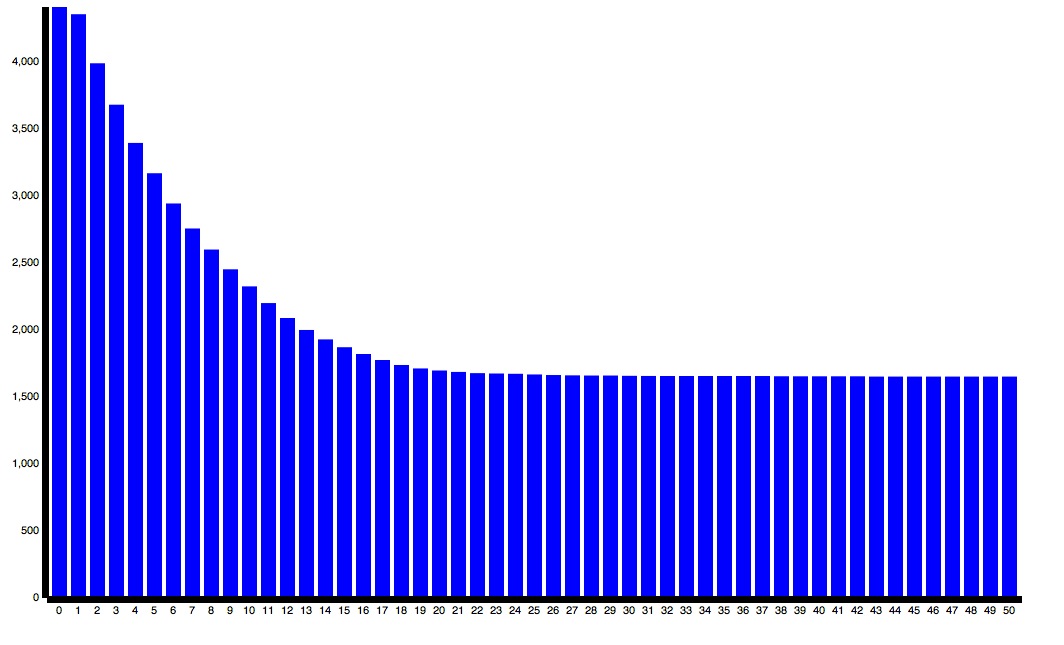AlgorithmBox is an algorithm development toolkit for solving discrete optimization problems. It provides a framework for implementing metaheuristic algorithms in javascript and an empirical experiment library for testing the algorithm against a number of standard optimization problems. It can be installed as a Node.js module via
npm install algorithmboxWith algorithmbox, you can write a few lines of javascript code to implement a local search algorithm and run it against problems such as TSP and SAT. AlgorithmBox defined a number of basic stochastic local search algorithms including
- Simulated Annealing https://en.wikipedia.org/wiki/Simulated_annealing
- Tabu Search https://en.wikipedia.org/wiki/Tabu_search
- Hill Climbing / Iterative Improvement https://en.wikibooks.org/wiki/Artificial_Intelligence/Search/Iterative_Improvement/Hill_Climbing
It also provides spec for the following optimization problems
- Travelling Sales Problem (TSP)
- Satisfiability Problem (SAT)
To implement a hill climbing algorithm for solving TSP, do the following
//base algorithm definition of hill climbing
var IIA = require('algorithmbox').IIA;
var defineClass = require('algorithmbox').defineClass;
//extend the framework-provided IIA definition
var MyIIA = defineClass({
name : "MyIIA",
extend : IIA,
methods : {
//given a candidate solution, return a set of neighborhood
//solutions that can be reached by 1-point mutation
'neighbors' : function neighbors(candidate) {
}
}
});To load a TSP problem instance from a file such as tsplib, do
var TSP = require('algorithmbox').TSP;
//load tsp instance from file
var raw = fs.readFileSync('tsplib/bayg29.xml');
//parse data and create a TSP instance
var instance = new TSP(TSP.parseData(raw));Now run the algorithm against the problem instance
//create a IIA algorithm with predefined terminate condition
var algs = new MyIIA(instance, {
'terminate_ls_steps' : 1000 //stop if maximum search steps reached
});
//run the algorithm and monitor progress
algs.run(function(step){
console.log("step %d. best found solution: [%s]", step, algs.best_sol);
if(algs.lo_trap)
console.log("trapped"); //algorithm trapped in local optima
}); AlgorithmBox provides a simple framework for experimenting with different problem instances and algorithm parameter configurations . To define an experiment
var Experiment = require('algorithmbox').Experiment;
var config = {
//test against TSP problem class
"tsp": {
//run each algorithm against each TSP instance loaded from a file
"instances" : ["bayg29.xml", "br17.xml"],
"algorithms": {
//setting for a user-defined Simulated Annealing algorithm
"tsp_sa": [
{
"boltzmanconst": 0.05,
"coolingscheme": "geometric"
}, {
"boltzmanconst": 0.005,
"coolingscheme": "geometric"
}, {
"boltzmanconst": 0.001,
"coolingscheme": "geometric"
},
]
//settings for a user-defined hill climbing algorithm
"tsp_iia": []
},
//total number of independent runs (with random restart)
"runs": 100,
//terminate condition for each run
"max_ls_steps" : 5000
}
};
To run the experiment and output the raw data result to a folder:
var session = new Experiment(config, "default.box");
session.run();To analyze the experimental result, use the Analyzer to load the experiment raw data
var Analyzer = require('algorithm').Analyzer;
//load runtime quality distribution result for a specific algorithm runed against a specific problem instance
var rqds = analyzer.get_runtime_quality("sat", "uf20-01.cnf", "gsat_iia", {"terminate_ls_steps" : 30});
var rqds2 = analyzer.get_runtime_quality("sat", "uf20-01.cnf", "gsat_iia", {"terminate_ls_steps" : 10});
var rsd = analyzer.get_runtime_solvability('sat', "uf20-01.cnf", "gsat_iia", {}, 85);
rsd = analyzer.get_runtime_solvability('tsp', "bayg29.xml", "tsp_iia", {}, 1800);
AlgorithmBox provides the following experimental analysis matrix
- Runtime Quality Distribution showing how solution quality changes over local search steps
- Runtime Solvability Distribution showing the probability of reaching a solution quality over local search steps
- Problem Solution Quality shows the average solution of the algorithm across mutlitple problem instances over a number of indepedent runs
For further details, please look into the test case examples.
#Visualization and Ploting A sample visualization is provided (test/test_visualization.js) that demonstrate how to use Socket.IO and D3 to visualize the runtime quality distribution of a typical experiment. In the test folder, do
nodeunit test_visualization.jsIn the browser, open
localhost:8888and you would obtain the runtime quality distribution showing how solution quality (Y Axis for minimization problem) improves over runtime (X axis as local search steps)
AlgorithmBox is still a new concept under developement. Contributors are welcomed.
Denny C. Dai ([email protected] http://dennycd.me)

